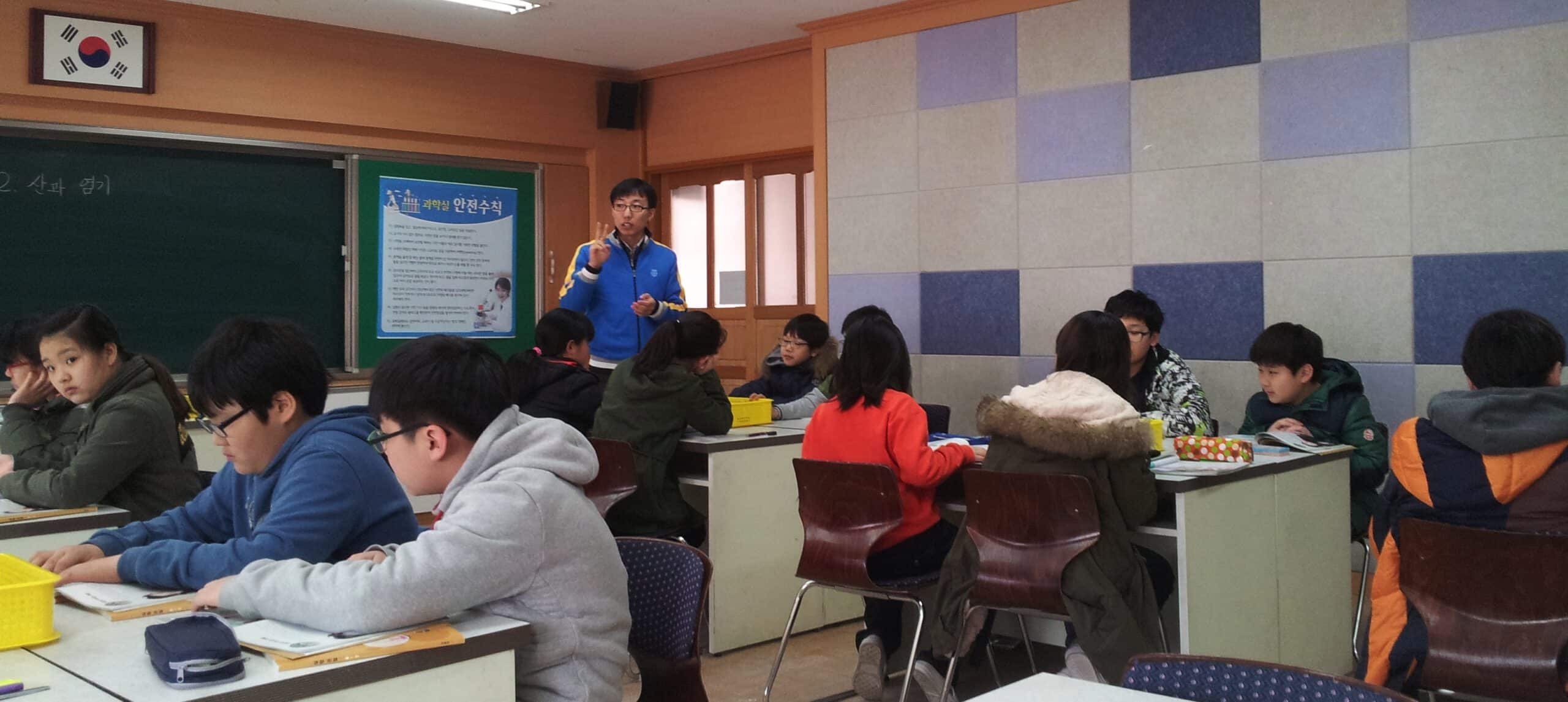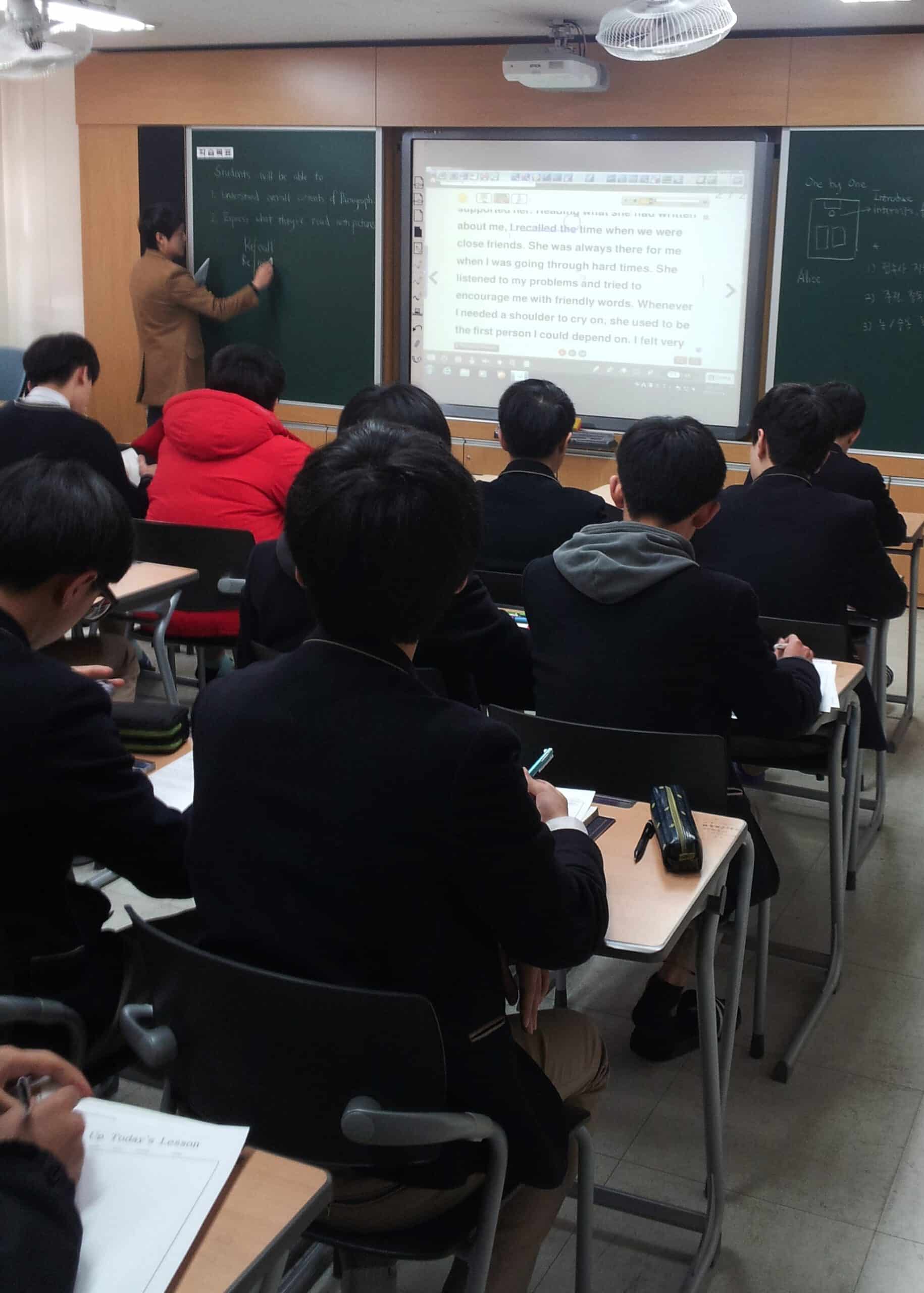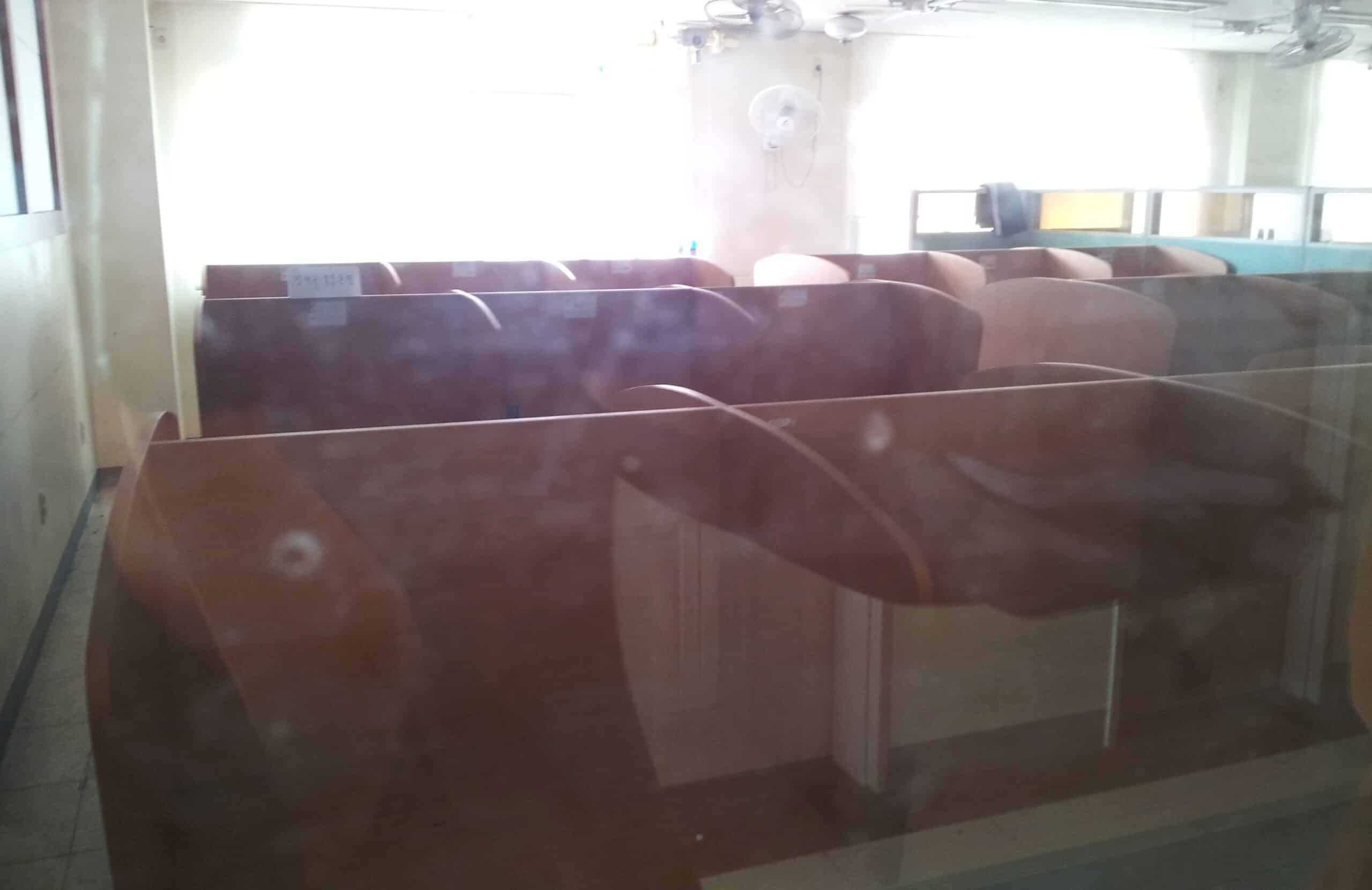My visits to South Korean schools—five so far with a few more scheduled—are starting to help me understand the differences between the different levels of schooling in this country.
In my visits to elementary schools, the classrooms I’ve seen have been a far cry from the Korean ones focused on rote memorization with nothing but lecture about which I was warned. In schools in Seoul and Gwangju, the classes I saw looked similar in many respects to what I might have seen in a classroom in the United States. In a public school science class in Gwangju for fifth graders, I was impressed by the lab experiment that the students did in small groups and how the teacher interacted with the students. It appeared to me to be far more advanced and interactive than many classes I have seen in the United States. The student-to-teacher ratio has been no higher than 24 students to one teacher, and the students seem to be happy.

A key reason for this, I have been told, is that in elementary school, the national College Scholastic Aptitude Test is many years away, so students have the time and ability to not focus so obsessively on memorizing facts, and parents are willing to have them expand their horizons some. Schools understand this, and with the push from the central government above to turn their classrooms into more discussion-oriented places and less one-way lecture zones, they have adjusted accordingly.
I did see big differences in the ability levels of the elementary school students though. In a lower socio-economic school in Gwangju, the teacher who took me around told me that while about half of the students start going to hagwons as early as first grade perhaps, many cannot afford it. When English class begins in third grade, the differences are apparent, as some students already know the English that they are being taught—the lesson is review in essence—whereas it’s new for others, who have far less confidence. Watching left me frustrated that the class was not able to use blended learning to personalize the learning for each child’s needs and escape what is still a factory model of education.
Preventing these differences I am sure is why the Korean National Assembly passed a bill that attempts to ban “advanced learning” by trying to clamp down on the practice of hagwons and public schools teaching students about subjects that they will learn in future years ahead of time. But this time-based rule, in my opinion, will not solve the problem, is treating the symptom not the cause, and represents a backward step away from the student-centered, competency-based learning that students need to be successful by limiting and stunting students’ learning arbitrarily based on age.
That said, having seen the humanity present in the elementary schools, I was not prepared for what I saw in a visit to a public high school in Daejeon. Like the elementary schools, there was plenty of technology—typically every classroom has a television that is controlled by a computer—and the students all wear uniforms. But that is where the similarities largely stopped.
The classes I sat in on had 29 students each, but as I walked the halls, I saw some classes that appeared to have nearly 40 people in them. Even though the school is coed, the classes are single gender. Boys and girls have little interaction with each other. With the exam for college looming, the message is clear: there is little time for distractions or exploration.
There are some leveled classes. For English and math, students take a test in the beginning of the year and are divided into different levels. During those 50-minute classes, students go to specific subject-matter rooms that are outfitted with Smartboards. In the English grammar class I observed, the teacher was adept at using the Smartboard to present the lesson, which was a lecture with various groups of students intermittently volunteering responses in mumbled voices without raising their hands.

For their other subjects, the students remain in their home classroom, and the subject-matter teachers come to them. This is the norm in many Korean high schools. Students decorate their home classroom over the course of the year, and teachers have their own offices in so-called subject-matter rooms with their fellow teachers. Interestingly, students study earth science, biology, chemistry, and physics every year I learned.
Students arrive at school at 7:30 a.m. High school has three grades. The 10th and 11th graders leave school at 10 p.m. Twelfth graders leave at 11 p.m. Students spend their last three hours at school in self-study in dark rooms with cubicles where no technology is allowed.

After leaving school, most students go directly to hagwons, despite it being illegal for hagwons to be open after 10 p.m. One student I spoke to said she goes home and logs on to Megastudy, an online hagwon, which she loves because she has great teachers that she chooses.
Although the students were focused in the classes I attended, it was hard to know if that was because they were on their best behavior with me there. When I walked through the rest of the school, I saw a different picture. Many teachers lectured to students with a microphone, while large number of students slept blatantly in all manner of positions. I had read about this practice beforehand, but seeing it was still shocking.
After my conversations with students, it was hard to blame them. They all said they only slept 5 to 6 hours a night. They learned much of the material at their hagwons, not at school. And when I asked them what was the one thing they would change about the Korean education system, nearly all said that they wanted freedom. As a small example, the girls complained not only about the mandatory uniforms, but also the mandatory hair length—in this school, their hair was required to be about shoulder height. Students often come in to school on the weekends as well for more studying I learned.
Although the school has clubs, they meet during specific periods during the week. The only time students had for leisure activities—like basketball—was on the weekend, and it is not much time. Students do have art and physical education classes.
At a public all-girls high school in Busan, I observed similar things. Although in the classes I attended the students were focused—in one math class the teacher walked around and worked with students on math problems individually—when I walked around the halls, I saw several students sleeping as teachers taught through the Smartboards that were in every room. Interestingly, I was told that many of the students are from families that cannot afford hagwons; the students do not attend Megastudy either, a teacher said. Students arrive at school at 7:50 a.m. School is over at 4:20 p.m. There is then a make-up class for English, math, or Korean, followed by an hour-long dinner, and then 2.5 hours of self-study before students leave at 9 p.m. Students go home presumably to work more, as I was told they don’t sleep much either at night. Students are also not allowed to leave in the middle of class for restroom breaks.
In the public high schools, students pay fees as well, including for tuition, the textbooks that they purchase, lunch and dinner, and their uniforms. The Busan school, which is in a particularly low-income neighborhood, provides tuition scholarships, thanks to a special government program for which it had applied and received, for the students who have financial hardships.
Despite what I saw, there are some areas for hope within the schools. A teacher in Daejeon told a television crew that trailed me to her school that she sees the rise of blended learning as inevitable ultimately. The students are so comfortable online, she said, as she showed us some amazing literary magazines they had created in their club time—also separated by gender. She said that the three-hour self-study time would present a natural opportunity to introduce online learning that would be so much more interactive and engaging than any textbook and could help make learning far more efficient.
If schools could do that and flip their classrooms—a first step into blended learning—then that might be the breakthrough Korean teachers need to step out of the lecture format and begin to make mainstream schools far more engaging and productive.


